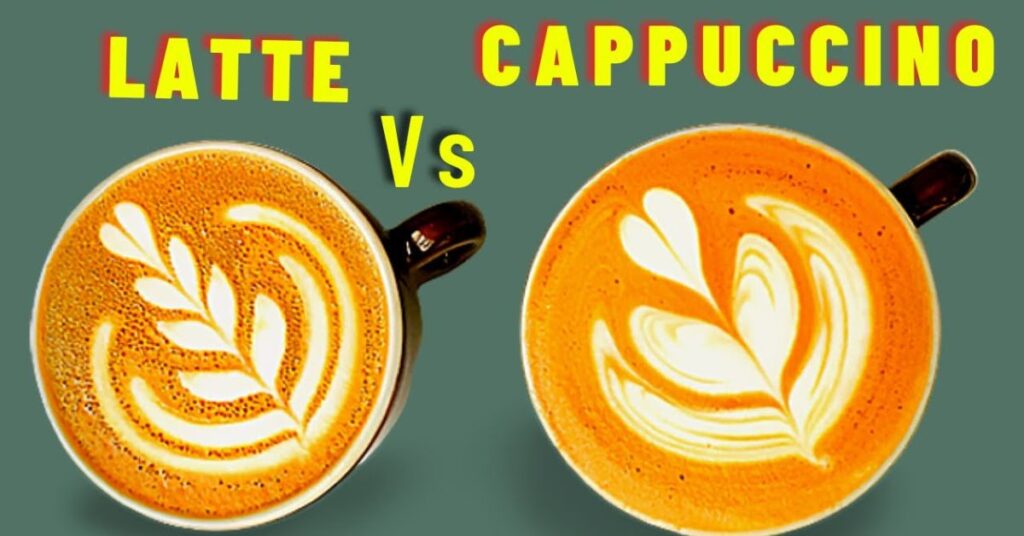Are you a coffee enthusiast who often wonders whether to order a latte vs cappuccino? Have you ever been confused about the differences between these two popular espresso-based drinks? If you’re looking to make the right choice between a latte and a cappuccino, this guide will give you a clear understanding of how they differ in flavor, texture, and preparation. Let’s dive into the details and help you make an informed decision for your next coffee order!
What is a Latte?
A latte, short for “caffè latte” (Italian for “milk coffee”), is one of the most popular drinks around the world. It’s a coffee drink made with one or two shots of espresso, a large amount of steamed milk, and a small layer of milk foam on top.
Key Features of a Latte:
- Espresso Shot: Lattes start with a shot of espresso, which forms the base of the drink. Some prefer two shots for a stronger flavor.
- Steamed Milk: A significant portion of the drink is made up of steamed milk, which gives the latte its creamy and smooth texture.
- Thin Foam Layer: A small amount of milk foam is added on top, but it’s much thinner than in a cappuccino.
What is a Cappuccino?
A cappuccino is a more balanced coffee drink that offers a richer coffee flavor due to the higher proportion of espresso. The drink is divided into three equal parts: one-third espresso, one-third steamed milk, and one-third foam.
Key Features of a Cappuccino:
- Equal Espresso and Milk: The cappuccino is known for its strong coffee flavor, balanced out by an equal amount of steamed milk.
- Thick Foam Layer: A thick, frothy layer of milk foam sits on top, which is a defining feature of the cappuccino. The foam is dense and gives the drink its velvety texture.
- Smaller Size: Cappuccinos are generally served in smaller cups, enhancing the espresso flavor compared to a latte.
Latte vs Cappuccino: What’s the Difference?
1. Milk Ratio and Texture
One of the most significant differences between a latte and a cappuccino is the ratio of milk to espresso and the texture of the foam.
- Latte: Lattes have more steamed milk than cappuccinos, which results in a creamier, smoother texture. The foam layer is thin and barely noticeable.
- Cappuccino: Cappuccinos contain less steamed milk but have a much thicker layer of foam. This creates a lighter, airier texture and a more pronounced coffee flavor.
2. Coffee Strength
The strength of coffee flavor differs significantly between the two drinks.
- Latte: Since lattes contain more steamed milk, the espresso flavor is more diluted. This makes lattes perfect for those who prefer a milder, less intense coffee taste.
- Cappuccino: Cappuccinos have a stronger coffee flavor due to the higher ratio of espresso to milk. The foam layer also helps retain the espresso’s bold taste.
3. Serving Size
The standard serving size for a latte is typically larger than that of a cappuccino.
- Latte: Lattes are usually served in larger cups, ranging from 8 to 12 ounces or even more, which gives you a more extended, milk-heavy coffee experience.
- Cappuccino: Cappuccinos are served in smaller portions, around 6 ounces, which highlights the intensity of the espresso without overwhelming the palate.
4. Preparation and Presentation
The method of preparation also varies between lattes and cappuccinos, leading to different appearances and drinking experiences.
- Latte: Baristas create lattes by pouring steamed milk directly into the espresso, creating a smooth blend. Often, the latte art on top adds a visual element.
- Cappuccino: Cappuccinos are carefully layered, with equal parts of espresso, steamed milk, and thick foam, creating distinct layers.
Which Drink is Right for You?
Now that you know the key differences between a latte and a cappuccino, you might be wondering which one is better suited for your taste. Here are some points to consider:
- Choose a Latte if:
- You enjoy a creamier, milkier drink with a subtle coffee flavor.
- You like adding flavored syrups (like vanilla, caramel, or hazelnut) to your coffee.
- You prefer a larger drink that lasts longer.
- Choose a Cappuccino if:
- You prefer a stronger, more intense coffee flavor.
- You enjoy the texture of thick, frothy foam on top.
- You like smaller, more concentrated coffee drinks.
The Origins and Cultural Significance
The origins of both the latte and the cappuccino can be traced back to Italy, where coffee culture has a deep history. Understanding where these drinks come from can give you a greater appreciation for their significance in the coffee world.
Latte Origins
The term “caffè latte” was popularized in Italy in the 19th century, but the drink gained international fame in the 20th century when it spread to cafes in Europe and the United States. Today, lattes are a staple in most coffee shops around the world and are often customized with various flavors, milk alternatives, and creative latte art.
Cappuccino Origins
The cappuccino is named after the Capuchin friars, a Catholic religious order. The drink’s name is thought to refer to the friars’ brown robes, which resemble the rich brown color of the espresso and milk mixture. Cappuccinos became widely popular in Italy in the 20th century and are traditionally enjoyed during breakfast.
Health and Nutritional Differences
If you’re health-conscious, it’s also important to know the nutritional differences between a latte and a cappuccino. The amount of milk used in each drink plays a role in their calorie count and overall nutritional value.
Latte Nutritional Facts
- Calories: A standard 12-ounce latte made with whole milk contains around 150-200 calories.
- Fat: Lattes contain more fat due to the larger amount of milk.
- Sugar: Depending on the milk and any added flavorings, lattes can have higher sugar content.
Cappuccino Nutritional Facts
- Calories: A standard 6-ounce cappuccino made with whole milk contains around 70-80 calories.
- Fat: Since cappuccinos have less milk, they contain less fat compared to lattes.
- Sugar: Cappuccinos typically contain less sugar unless sweeteners or syrups are added.
If you’re looking to reduce calories or fat, you can opt for alternative milks like almond, oat, or soy, which are often available at most cafes.
Customizing Your Latte or Cappuccino
Whether you choose a latte or a cappuccino, both drinks can be customized to suit your preferences. Here are some common ways to personalize your coffee experience:
Milk Options:
- Almond milk: Offers a slightly nutty flavor and is lower in calories.
- Oat milk: Creamy and rich, it’s a favorite for those avoiding dairy.
- Soy milk: A popular dairy-free alternative with a mild taste.
Flavored Syrups:
Add syrups like vanilla, caramel, or hazelnut to your latte or cappuccino for an extra layer of sweetness and complexity.
Extra Shots:
If you prefer a stronger coffee flavor, you can request an extra shot of espresso in your latte or cappuccino.
Fun Facts About Latte vs Cappuccino
- Latte Art: The practice of creating patterns or designs in the foam of a latte has become an art form. Popular designs include hearts, leaves, and even intricate portraits!
- Cappuccino Contests: Baristas around the world compete in cappuccino foam art competitions to showcase their skills in creating perfectly layered drinks.
- Different Cappuccino Variations: In Italy, there’s a drink called “dry cappuccino” with less milk and more foam, offering an even stronger espresso flavor.
Conclusion:
Choosing between a latte vs cappuccino ultimately depends on your personal taste preferences. If you enjoy a creamy, mild coffee experience with a lot of milk, a latte is the way to go. However, if you prefer a more robust, espresso-forward flavor with a rich foam texture, a cappuccino is your best bet.
Both drinks have earned their place in the coffee world and continue to be popular choices in cafes worldwide. Whether you enjoy them as-is or with customized flavors and milk alternatives, you can’t go wrong with either option!
FAQs
1. Can I make a latte or cappuccino at home?
Yes! With an espresso machine or even a stovetop espresso maker and milk frother, you can easily make both lattes and cappuccinos at home.
2. What’s the main difference between a latte and cappuccino?
The main difference is the milk ratio. Lattes have more steamed milk and less foam, while cappuccinos have equal parts of espresso, steamed milk, and foam.
3. Which drink is stronger, a latte vs cappuccino?
Cappuccinos have a stronger coffee flavor because they contain less milk, allowing the espresso to stand out more than in a latte.
4. Can I add flavor to my latte vs cappuccino?
Yes, you can add syrups like vanilla, caramel, or hazelnut to both lattes and cappuccinos for a sweet, customized flavor.







